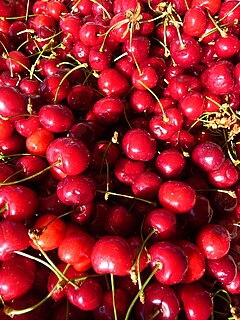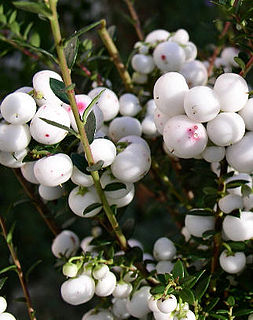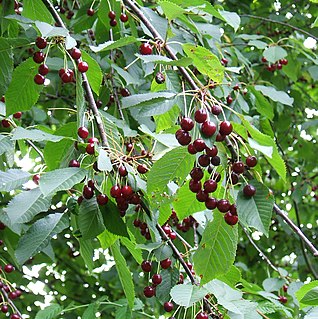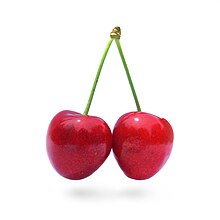
A cherry is the fruit of many plants of the genus Prunus, and is a fleshy drupe.

Prunus cerasus is a species of Prunus in the subgenus Cerasus (cherries), native to much of Europe and southwest Asia. It is closely related to the sweet cherry, but has a fruit that is more acidic. Its sour pulp is edible.

Feijoa sellowiana is a species of flowering plant in the myrtle family, Myrtaceae. It is native to the highlands of southern Brazil, eastern Paraguay, Uruguay, northern Argentina, and Colombia. It is widely cultivated as an ornamental tree and for its fruit. Common names include feijoa, pineapple guava and guavasteen, although it is not a true guava. It is an evergreen shrub or small tree, 1–7 metres (3.3–23.0 ft) in height.

Pollination of fruit trees is required to produce seeds with surrounding fruit. It is the process of moving pollen from the anther to the stigma, either in the same flower or in another flower. Some tree species, including many fruit trees, do not produce fruit from self-pollination, so pollinizer trees are planted in orchards.

The damson or damson plum, also archaically called the "damascene", is an edible drupaceous fruit, a subspecies of the plum tree. Varieties of insititia are found across Europe, but the name damson is derived from and most commonly applied to forms that are native to Great Britain. Damsons are relatively small ovoid plum-like fruit with a distinctive, somewhat astringent taste, and are widely used for culinary purposes, particularly in fruit preserves and jams.

Prunus cerasifera is a species of plum known by the common names cherry plum and myrobalan plum. It is native to Southeast Europe and Western Asia, and is naturalised in the British Isles and scattered locations in North America. Also naturalized in parts of SE Australia where it is considered to be a mildly invasive weed of bushland near urban centers.

Ziziphus mauritiana, also known as Indian jujube, Indian plumChinese date, Chinee apple, and dunks is a tropical fruit tree species belonging to the family Rhamnaceae.

Rainier is a cultivar of cherry. It was developed in 1952 at Washington State University by Harold Fogle, and named after Mount Rainier. It is a cross between the 'Bing' and 'Van' cultivars.

Gaultheria mucronata, the prickly heath, is a species of flowering plant in the family Ericaceae, native to southern Argentina and Chile.

Prunus avium, commonly called wild cherry, sweet cherry, gean, or bird cherry is a species of cherry, a flowering plant in the rose family, Rosaceae. It is native to Europe, Anatolia, Maghreb, and Western Asia, from the British Isles south to Morocco and Tunisia, north to the Trondheimsfjord region in Norway and east to the Caucasus and northern Iran, with a small isolated population in the western Himalaya. The species is widely cultivated in other regions and has become naturalized in North America and Australia.
The 'Laxton's Superb' is an apple cultivar that was developed in England in 1897. It is a cross breed between 'Wyken Pippin' and 'Cox's Orange Pippin'. It is a British apple with a green color and a dull red flush. It is a firm-textured dessert apple. The fruit is well known for its sweet and aromatic taste which is likened to the parent species it is derived from, the 'Cox's Orange Pippin'.

Winston is an English cultivar of domesticated apple which was first named Winter King because of its availability in the winter, but was renamed as Winston in 1944 or in 1945, after Winston Churchill.
The Chelan cherry is a cultivar of cherry. It is a hybrid of the Stella and Beaulieu varieties first developed in Prosser, WA.

Lapins is a cultivar of cherry. It is a hybrid of the Van and Stella cultivars. It has been awarded the Royal Horticultural Society's Award of Garden Merit.
The Pacific Agri-Food Research Centre is an agricultural research centre in British Columbia, Canada. The centre has been historically important in the development of tree fruits. It is administered by Agriculture and Agri-Food Canada and includes sites at Summerland and Agassiz.
Van is a cultivar of cherry originating from Canada.
The Sweetheart cherry is a cultivar of cherry. It is a hybrid of the Van and Newstar cultivars first developed in Canada.
Skeena is a cultivar of cherry originating in Canada.
Tieton is a cultivar of sweet cherry developed in Washington state.

The Concorde is a cultivar of pear originating in England. A cross of the Conference and Comice varieties, it has some of the traits of both parents.














